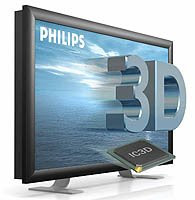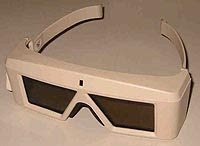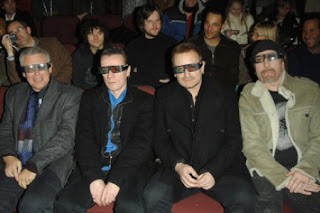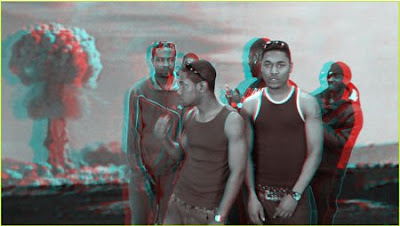
Beowulf in 3-D on DVD? Not happening. Not today.
So what’s up with this? An awful lot of talk about 'Beowulf' being in 3-D and then when it comes to DVD release time, no 3-D version in sight. Not even close, nada, nothing.
The studio and distributor refuse to have you, the paying consumer, choose to see this movie on DVD in 3-D, in whatever 3-D format you choose. You would pay for it and you may even be willing to don the gear, like anaglyph glasses, field-sequential shutterglasses, Sensio 3-D decoding or even on an auto-stereoscopic 3-D Plasma TV. But you can’t because the reasoning of the men in power is like this: 3-D is what makes people come to the cinema and be willing to pay more than a regular cinema ticket. Hmm, but what about getting even more cash from home 3-D sales? Well, the distributors have been told by the Real-D and Dolby 3-D people that there is no way in which a home audience an enjoy 3-D like in the cinema, so one had better not release it in any of the available 3-D formats at all. So much for selling 3-D Plasma screens then eh?

The same cruel fate has been bestowed upon the 'Polar Express', 'Monster House', 'Superman Returns', 'Harry Potter and the Order of the Phoenix', 'Chicken Little', 'Open Season' and 'Meet the Robinsons'. And forget about the 200 or so 3-D titles from before 2003. You will never see them again if it’s up to Hollywood, if only maybe, possibly in re-released cinematic form, if you’re lucky. 'Hondo' is one such title that has been restored and brightened up for a 3-D release. Not a re-release in 3-D, as this is the first time it will be played in 3-D in movie theatres. What I’m really talking about are such jewels of 3-D cinematic history as ‘Jaws 3-D’, ‘Creature from the Black Lagoon’, ‘Kiss me Kate’, ‘Dial M for Murder’, ‘Metalstorm’... ah, the list goes on and on.
‘Shrek 4-D’, ‘Spy Kids 3-D’, ‘Sharkboy & Lavagirl’ and ‘Barbie & the Magic of Pegasus’ were all released in anaglyph 3-D on DVD, while ‘Ghosts of the Abyss’, ‘Nascar 3-D’ and ‘Santa vs. the Snowman’ were released in field-sequential DVD format. Did those releases make anybody stop from going to the cinema and see 3-D or 2-D movies? No, of course not, nor did it spawn a crazy 3-D piracy binge. So what’s stopping the movers & shakers of Tinseltown?

Analgyph 3D isn’t the only format possible for 3-D DVD release. So what is actually possible and not used to release current 3-D film titles on DVD or HD-DVD / BlueRay DVD in 3-D?
1) Anaglyph 3-D. Red & Blue. I can hear the likes of James Cameron shouting from the back of the room: “Boo! Red Blue Bad! Away with the Devil’s 3-D tool!” Well, it works, it’s cheap to produce, the glasses are easy & cheap and no modifications are required to the TV set. A no-brainer then? True, there are some problems with anaglyph for TV in terms of colour reproduction and ghosting, but it’s not as bad as Cameron makes it sound. Better to see a film in a lesser 3-D format than not at all, IMHO!

2) Field-sequential 3-D. Electronic shutterglasses, AKA CrystalEyes. No booing this time, other than for the slow refresh rate of the TV signal (50/60Hz), which means heavy flickering and bad results for epileptics. Until the broadcast and DVD signal go to higher refresh rates, this will remain a problem. Currently, there is little development in this area.

3) Polarized 3-D on a screen with an active polarizer / polarizing surface. Really wonderful and in terms of quality close to the cinematic 3-D experience. Just on a much smaller screen, so the 3-D is much less impressive and much flatter. But that happens with any 3-D presentation format. Technically, this is still a tricky proposition and I know of only one screen and one screen adapter that can polarize field or frame-sequentially. Again, frame refresh rate is an issue, unless the DVD is encoded in something like Sensio format or a side-by-side anamorphic or checker format playing off a computer. But then you’ll need some hardware or software to decode that signal to work with the polarizer as well. Not commercially available at Best Buy, nor easy to set up in a living room, practically speaking.

4) Freeview glassless 3-D on a Plasma screen. Really wonderful and the stuff of people’s dreams, but again you’ll need the specially encoded source material and hardware or software to turn that signal into a lenticular-ready image. Very difficult and expensive to set up in the living room, as yet.

5) Polarized projection with twin projectors or a 3-D ready projector, onto a silver screen. Projection in your living room? Better keep those curtains closed at all times and not paint the wall in that lovely creamy yellow. Otherwise, you’ll be good to go with something of a computer setup to drive the twin-projectors. Ah, yes.

Watch U2 3D with Bono at your local multiplex or at home -
if it's released on 3D DVD, that is.
In short I would conclude that in order for a 3-D revolution to truly take off, home entertainment must not be overlooked and 3-D titles must be release on DVD in present day 3-D stereoscopic formats. In terms of cost and availability of hardware that quickly points to anaglyph 3-D presentation. Boo! Hiss! Yeah, but at least people can enjoy the 3-D at home after having shelved out for the more expensive cinema ticket! And what could possibly be wrong with that?





